History
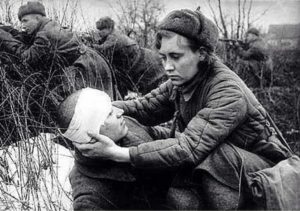 When Natalia Peshkova was a girl in high school, during the early years of World War II, women were not allowed to join the Russian Army. Nevertheless, the women of Russia wanted to help, just like women from most of the Allied nations. As the war went on, the need for soldiers brought women into the draft…like it or not. Peshkova found herself recruited right out of high school, and at the age of 17, she was set to be a combat medic.
When Natalia Peshkova was a girl in high school, during the early years of World War II, women were not allowed to join the Russian Army. Nevertheless, the women of Russia wanted to help, just like women from most of the Allied nations. As the war went on, the need for soldiers brought women into the draft…like it or not. Peshkova found herself recruited right out of high school, and at the age of 17, she was set to be a combat medic.
Things were tough in the arena Peshkova found herself in. The poorly equipped unit was faced with weapons that continuously malfunctioned…not a good thing to defend yourself with. Peshkova’s stint in the Russian army was filled with constant disease, starvation, and even the loss of a boot to a hungry horse, while she slept. To say the least, life in the Russian army was tough.
Despite the hardships, Peshkova did her duty as a combat medic, protecting and helping soldiers that were wounded on the front lines as much as she could. Her training taught her to protect wounded soldiers from the front and get them safely to hospitals, often placing herself in possible harm’s way. While she was trained to apply first aid, her main duty was always to remove wounded men from the front line. Trying to do first aid on the front lines was a dangerous maneuver for both soldier and medic. Peshkova was wounded three times for her efforts, but she had a kind of strength and determination that was unmatched in the field, and she always returned to the front when she had healed. I’m sure many people thought she was half crazy.
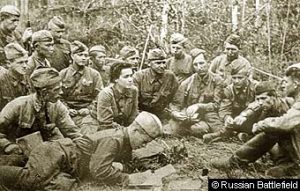
At one point, Peshkova got separated from her unit, finding herself behind enemy lines when the Germans took over territory previously held by the Russians. She had to act fast, so she disguised herself, while also hiding her weapon, because if she discarded it, she would have been executed by her own military. She finally made it back to her unit and survived three years on the front lines. She rose through the ranks to become Sergeant Major, and was then given political education duties that finally relived her from life on the front lines. Natalia Peshkova was truly one of a kind, and was awarded the Order of the Red Star for Bravery.
 Built in Seattle, Washington by Boeing, the B-17G, which was later converted to a B-17H for use as an emergency air-sea rescue plane. It was equipped with a Higgins A-1 lifeboat attached to the lower fuselage. The plane and crew including Pilot, 1st Lieutenant William C Motsinger; Co-Pilot, 2nd Lieutenant Robert W Ball; Crew, 1st Lieutenant Rollin C Marsh; Engineer, Captain Norman E Zahrt; Navigator, Technical Sergeant Robert W Conger; Gunner, Staff Sergeant Gerard J Doody; Crew, Staff Sergeant Charles J Parkins; Crew, Sergeant Charles Edward Hurn; Crew, Sergeant Elliott Leroy Griffin; and Crew, Sergeant Otis E Anderson Jr; was assigned to the 20th Air Force, 4th Emergency Rescue Squadron. The plane was given no known name or nose art, which happened more than people knew, but it had a Radio Call Sign of “Jukebox 21.”
Built in Seattle, Washington by Boeing, the B-17G, which was later converted to a B-17H for use as an emergency air-sea rescue plane. It was equipped with a Higgins A-1 lifeboat attached to the lower fuselage. The plane and crew including Pilot, 1st Lieutenant William C Motsinger; Co-Pilot, 2nd Lieutenant Robert W Ball; Crew, 1st Lieutenant Rollin C Marsh; Engineer, Captain Norman E Zahrt; Navigator, Technical Sergeant Robert W Conger; Gunner, Staff Sergeant Gerard J Doody; Crew, Staff Sergeant Charles J Parkins; Crew, Sergeant Charles Edward Hurn; Crew, Sergeant Elliott Leroy Griffin; and Crew, Sergeant Otis E Anderson Jr; was assigned to the 20th Air Force, 4th Emergency Rescue Squadron. The plane was given no known name or nose art, which happened more than people knew, but it had a Radio Call Sign of “Jukebox 21.”
B-17H Flying Fortress Serial Number 43-38882, aka Jukebox 21, took off from Motoyama Number 1 Airfield on Iwo Jima, on July 25, 1945, on a night search mission for F4U Corsair 81319 that crashed the day before near Arai at roughly over Lat 34° 35′ N, Long 137° 35′ E on the southern coast of Honshu, Japan. The weather was good, and yet Jukebox 21 was lost, without making a distress signal. That fact made the circumstances of the crash hard to figure, and only known when the B-17 failed to return. The crew was officially listed as Missing In Action, and later as killed in action.
The B-17 flew over Maisaka near the Benten Jima bridge, flying northward at an altitude of roughly 984 feet. Crossing the coast, 75mm anti-aircraft guns on the south side of the highway at Benten Jima opened fire on the bomber. Jukebox 21 was hit by anti-aircraft fire, one of the engines began smoking as the plane flew northward, then attempted to circle to the west over Lake Hamana, then southward. Trailing black smoke, one of the engines on the right wing broke off before the bomber crashed at Yakute to the northwest of Arai. Jukebox 21 impacted pine trees before crashing into the ground nose first at Yakute, to the northwest of Arai. Immediately after the crash, Japanese civilians ran to the crash site and observed several mounds of debris and fire and observed the rescue boat in the wreckage. There were no survivors. Thirty minutes after the crash, Japanese Keibodan (wartime guards) reached the crash site and extinguished the fire. The bodies of the ten crew were recovered, all badly burned from the fire and no identification was possible. Afterwards, the bodies of the crew were cremated and buried at the nearby Arai crematorium, along with the body of the Corsair pilot that crashed the previous day.

Twelve Allied aircraft participated in a search over two days under the direction of Major Ivan K Mays. No wreckage was located, and all stations and ships were told to be on the lookout for this bomber. On May 22, 1947 US Army investigators visited Arai to investigate the possibilities of any atrocities in connection with the death of this crew, but found none. During their visit, they interrogated Katsumi Kumagai the former Kempei Tai commander for Arai who explained how the B-17 crashed and how the crew’s bodies were recovered, cremated, and buried. Afterwards, the remains of the crew were recovered and transported to the United States for permanent burial. Somewhat strangely, the Japanese placed a memorial to the men of Jukebox 21 at the Jingu-ji Temple in Kosai, Japan.
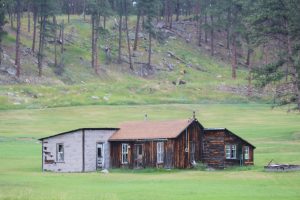 When we think of “ghost towns,” we think of abandoned mining camps, towns that were passed by when railroads or highways went through, and these days, New York City. There are many ways for a town or even a city to die out…most of them are really sad. Sometimes, a town just outlives its usefulness, as was the case during the gold rush. When the gold ran out, the miners moved on or went back east to their homes there. The little town that had provided the supplies, homes, entertainment, and necessary offices, like post office and land offices, is simply not needed anymore. I’m sure that the people of the town held out as long as it made sense, and then they picked up and moved on to some other place that needed things like a general store for supplies. The little town then sat there and slowly slipped into disrepair and decay. When we visit such towns, we see history unfolding before us, and we are usually excited to find such an amazing relic. We can’t wait to explore.
When we think of “ghost towns,” we think of abandoned mining camps, towns that were passed by when railroads or highways went through, and these days, New York City. There are many ways for a town or even a city to die out…most of them are really sad. Sometimes, a town just outlives its usefulness, as was the case during the gold rush. When the gold ran out, the miners moved on or went back east to their homes there. The little town that had provided the supplies, homes, entertainment, and necessary offices, like post office and land offices, is simply not needed anymore. I’m sure that the people of the town held out as long as it made sense, and then they picked up and moved on to some other place that needed things like a general store for supplies. The little town then sat there and slowly slipped into disrepair and decay. When we visit such towns, we see history unfolding before us, and we are usually excited to find such an amazing relic. We can’t wait to explore.
Sometimes, as in the case of New York City, a city is “shut down” to help those within it to recover from something, such as a pandemic. That doesn’t usually happen when a new virus goes through, but it did with 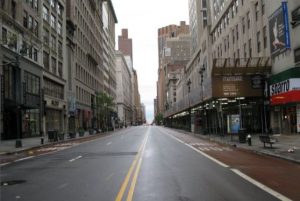 Covid-19. Normally, only the sick people are quarantined, but in this case, the medical experts (and many people would say that I’m using that term loosely), decided to quarantine the well people in the hope of stopping the spread of Covid-19. I can’t say whether that has been a good or a bad thing, but I tend to think it was a bad thing. When a city like New York City, suddenly is completely empty, businesses are shut down, jobs lost, and it didn’t seem to help. Months later, the city is still, for the most part, shut down, and businesses are considering a move to another location, just like the ghost towns of the old west when the mines dried up. The shut down of our cities is a slippery slope, and one that I think needs to be avoided, at all costs. Still, man will tell you that I’m not an expert, and they would be right. I am just a person who sees that our country cannot continue with this shut down much longer. Something has to change…something!!
Covid-19. Normally, only the sick people are quarantined, but in this case, the medical experts (and many people would say that I’m using that term loosely), decided to quarantine the well people in the hope of stopping the spread of Covid-19. I can’t say whether that has been a good or a bad thing, but I tend to think it was a bad thing. When a city like New York City, suddenly is completely empty, businesses are shut down, jobs lost, and it didn’t seem to help. Months later, the city is still, for the most part, shut down, and businesses are considering a move to another location, just like the ghost towns of the old west when the mines dried up. The shut down of our cities is a slippery slope, and one that I think needs to be avoided, at all costs. Still, man will tell you that I’m not an expert, and they would be right. I am just a person who sees that our country cannot continue with this shut down much longer. Something has to change…something!!
While we like to visit ghost towns, we often don’t realize the hardship and heartache that went into turning these places into ghost towns. Just like we have seen in the cities across America, the business shutting down  means the loss of a livelihood for millions of people. Depression sets in, and eventually everyone is angry about their rights being stepped on…and it’s not just one group, it’s many. Then, the sad thing is that there emerges a group of people who are…left out. The ones who don’t fit into any of the protesting groups…they are the quiet majority…the ones who usually just go quietly about their daily lives, without hurting anyone. Sadly these are the overlooked ones, and usually the last ones to leave the ghost town, because they are the ones who try to hope for the future. These days, that is much of America. We are just hanging out, waiting for things to get better, so we can get back to normal. Here’s to normal.
means the loss of a livelihood for millions of people. Depression sets in, and eventually everyone is angry about their rights being stepped on…and it’s not just one group, it’s many. Then, the sad thing is that there emerges a group of people who are…left out. The ones who don’t fit into any of the protesting groups…they are the quiet majority…the ones who usually just go quietly about their daily lives, without hurting anyone. Sadly these are the overlooked ones, and usually the last ones to leave the ghost town, because they are the ones who try to hope for the future. These days, that is much of America. We are just hanging out, waiting for things to get better, so we can get back to normal. Here’s to normal.
 Most of us know Julia Child as a famous chef, who mainly focused on French cuisine, as well as an author of cookbooks, but that is only one aspect of her life. Born Julia Carolyn McWilliams in Pasadena, California on August 15, 1912, she was the daughter of John McWilliams Jr, and Julia Carolyn “Caro” (Weston) McWilliams. She came from wealth as privilege, her dad being a Princeton Graduate and prominent land manager, and her mom being a paper-company heiress. She was the eldest of three children, followed by John McWilliams III and Dorothy (McWilliams) Cousins. Child and her siblings were all unusually tall, and loved outdoor sports. After she graduated, Julia went on to major in history in college, after college took a job as a copywriter for a furniture company in New York City.
Most of us know Julia Child as a famous chef, who mainly focused on French cuisine, as well as an author of cookbooks, but that is only one aspect of her life. Born Julia Carolyn McWilliams in Pasadena, California on August 15, 1912, she was the daughter of John McWilliams Jr, and Julia Carolyn “Caro” (Weston) McWilliams. She came from wealth as privilege, her dad being a Princeton Graduate and prominent land manager, and her mom being a paper-company heiress. She was the eldest of three children, followed by John McWilliams III and Dorothy (McWilliams) Cousins. Child and her siblings were all unusually tall, and loved outdoor sports. After she graduated, Julia went on to major in history in college, after college took a job as a copywriter for a furniture company in New York City.
With the onset of World War II, Julia tried to enlist in military service, but was told that she was too tall to enlist in the Women’s Army Corps (WACs) or in the U.S. Navy’s WAVES…both facts that make no sense to me, and probably would not have been a factor these days. Nevertheless, Julia was declined that chance to serve. 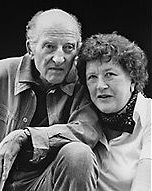 Undeterred, she joined the Office of Strategic Services (OSS) as a typist at its headquarters in Washington but, because of her education and experience, soon was given a more responsible position as a top-secret researcher working directly for the head of OSS, General William J. Donovan. Thus began a career that would lead to being a spy for the Allied forces and have a life changing effect on Julia’s life.
Undeterred, she joined the Office of Strategic Services (OSS) as a typist at its headquarters in Washington but, because of her education and experience, soon was given a more responsible position as a top-secret researcher working directly for the head of OSS, General William J. Donovan. Thus began a career that would lead to being a spy for the Allied forces and have a life changing effect on Julia’s life.
In 1944, she was posted to Kandy, Ceylon (now Sri Lanka). Her responsibilities included “registering, cataloging and channeling a great volume of highly classified communications” for the OSS’s clandestine stations in Asia. Later she was transferred to Kunming, China, where she received the Emblem of Meritorious Civilian Service as head of the Registry of the OSS Secretariat. Asked to solve the problem of too many OSS underwater explosives being set off by curious sharks, “Child’s solution was to experiment with cooking various concoctions as a shark repellent,” a task she did in a bathtub…not much like her cooking in later years. The chemicals were sprinkled in the water near the explosives and repelled sharks…it was a great success and is still in use today. The experimental shark repellent “marked Child’s first foray into the  world of cooking” Child received an award that cited her many virtues, including her “drive and inherent cheerfulness.”
world of cooking” Child received an award that cited her many virtues, including her “drive and inherent cheerfulness.”
While in Kunming, she met Paul Cushing Child, also an OSS employee, and the two were married September 1, 1946, in Lumberville, Pennsylvania. They later relocated to Washington DC. Paul was a New Jersey native who had lived in Paris as an artist and poet. He was also known for his sophisticated palate, and introduced his wife to fine cuisine. Julia had always had a cook in her childhood home, so the idea of cooking was very foreign to her. Still, she was smart, and she began to excel in the art of cooking. It was her cooking that helped her to realize another of her goals…to become an author. Cooking was not a goal is a girl, but it was her later love of cooking that finally gave her the title of writer she had so desired. While Julia and Paul never had children, they lived a long and happy life until his passing in 1994. Then she went on until her own passing in 2004 at the good old age of 91.
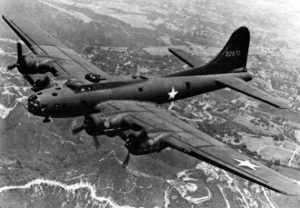
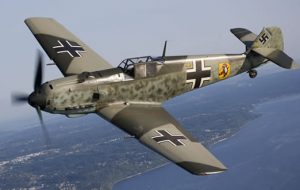 When the B-17 was built, it was designed to be a formidable weapon against the enemy, namely the Nazis and the Japanese. Early on, before long-range fighter escorts came into being, B-17s had only their .50 caliber M2, the B-17s were on their own out there. Still, the B-17 was not defenseless. With those .50 caliber M2s, the crew had the ability to fire at the enemy from every direction…almost. The job of the Messerschmitt fighters was to take down the B-17s. The Messerschmitt fighter planes were designed to break world air speed records. They were also the hope of the Germans to take down the B-17s. Still, there were all those guns to deal with. Luftwaffe fighter pilots agreed that attacking a B-17 combat box formation to encountering a fliegendes Stachelschwein, “flying porcupine,” with dozens of machine guns in a combat box aimed at them from almost every direction. The biggest downfall of the B-17 bombing formation was that they had to fly straight, making them vulnerable to German flak. It was the first line of defense the Germans had when the bombers came in.
When the B-17 was built, it was designed to be a formidable weapon against the enemy, namely the Nazis and the Japanese. Early on, before long-range fighter escorts came into being, B-17s had only their .50 caliber M2, the B-17s were on their own out there. Still, the B-17 was not defenseless. With those .50 caliber M2s, the crew had the ability to fire at the enemy from every direction…almost. The job of the Messerschmitt fighters was to take down the B-17s. The Messerschmitt fighter planes were designed to break world air speed records. They were also the hope of the Germans to take down the B-17s. Still, there were all those guns to deal with. Luftwaffe fighter pilots agreed that attacking a B-17 combat box formation to encountering a fliegendes Stachelschwein, “flying porcupine,” with dozens of machine guns in a combat box aimed at them from almost every direction. The biggest downfall of the B-17 bombing formation was that they had to fly straight, making them vulnerable to German flak. It was the first line of defense the Germans had when the bombers came in.
In a 1943 survey, the USAAF found that over half the bombers shot down by the Germans had left the protection of the main formation. The Germans needed a training plan. The United States developed the bomb-group formation, which evolved into the staggered combat box formation in which all the B-17s could safely cover any others in their formation with their machine guns, making a formation of bombers a dangerous target to engage by enemy fighters. The Messerschmitt fighters were fast, but they could not just fly at the formation. They would be shot down for sure. So, they looked for the bomber that had been hit and had to pull out of formation. Then they would move in for the kill. Moreover, German fighter aircraft later developed the tactic of high-speed strafing passes rather than engaging with individual aircraft to inflict damage with minimum risk. It was a way of not fully engaging the “flying porcupine.” As a result, the B-17s’ loss rate was up to 25% on some early missions. They needed something more to provide a kind of shield against the enemy.
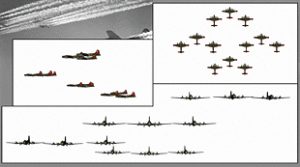
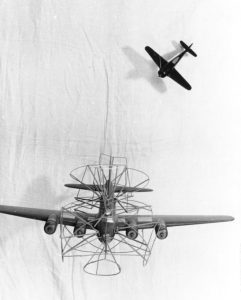
It was not until the advent of long-range fighter escorts (particularly the North American P-51 Mustang) and the resulting degradation of the Luftwaffe as an effective interceptor force between February and June 1944, that the B-17 became strategically potent. They needed the P-15 Mustang to keep the Messerschmitts off of them. So in the end, the German training didn’t do them much good against the “flying porcupine.”
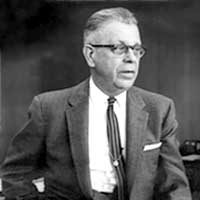 Life was not easy for Percy Lebaron Spencer, who was born to Louis and Lillian (Ottenheimer) Spencer in Howland, Maine on July 19, 1894. His father passed away when he was still a toddler and he was abandoned by his mother soon after. Spencer was brought up by his poverty-stricken uncle and aunt, who barely had enough to get by themselves. When he was seven, tragedy struck again, when his uncle died, leaving him to be the unofficial head of the household, a job he took seriously. Soon after his uncle’s passing, Spencer left school to earn a living and support himself and his aunt.
Life was not easy for Percy Lebaron Spencer, who was born to Louis and Lillian (Ottenheimer) Spencer in Howland, Maine on July 19, 1894. His father passed away when he was still a toddler and he was abandoned by his mother soon after. Spencer was brought up by his poverty-stricken uncle and aunt, who barely had enough to get by themselves. When he was seven, tragedy struck again, when his uncle died, leaving him to be the unofficial head of the household, a job he took seriously. Soon after his uncle’s passing, Spencer left school to earn a living and support himself and his aunt.
Spencer as a very curious boy, who always wanted to know how things worked, once spending days exploring a log hauler truck that broke down in front of his house, trying to figure out how it worked. That curiosity never left him, and was at the root if his inventor’s mind. Between the ages of 12 and 16 he worked at a spool mill. He left the mill upon learning about an opening at a paper factory that was going to be run on electricity. Living in a remote town, an electrically run factory was exciting and new, and something that Spencer’s mind could not resist. This was a new concept in the remote town where he lived. He didn’t know much about electricity, so he learned as much as he could about it and applied for the job of wiring the plant. He was one of three people chosen for the job. Which is amazing to me, because he was not a trained electrician, but then I guess no one else was either. Still, he had no training of any kind, and learned his job…on the job.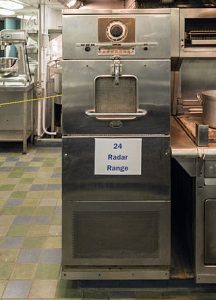
At the age of 18, Spencer’s took another turn, but this one was not a tragedy. He joined the United States Navy and it was there that he learned about wireless and radio technology. Always highly motivated, Spencer learned and gained expertise in a number of fields such as trigonometry, calculus, chemistry, physics, and metallurgy by reading extensively about them. He also became an expert in radar tube design, and worked at a company called Raytheon as the chief of the power tube division. Spencer was a great asset to Raytheon, and his expertise helped the company win a major contract from the US government to produce magnetrons for radar equipment which was became invaluable in the second world war. Under his leadership, the division expanded from a mere 15 employees to more than 5000 employees and productivity was also largely improved.
Probably the most commonly used of Spencer’s inventions in modern times, and one many people might not know was his invention, was the microwave oven. What household doesn’t have one? This invention was purely coincidental, though. One day while working at the plant, he crossed an active radar set when he noticed that the candy in his pocket had suddenly melted. His curiosity was immediately heightened, and he set about finding out how that had happened. He decided to experiment further by testing out different types of foods, such as unpopped kernels of corn. To his surprise and delight, they began to pop. Unlike others who had experienced the same, Spencer was keen to learn more about it.
Spencer began to research further, and documented his findings. Then he filed for and was granted a patent in  1945. In 1947, he produced the first commercially built microwave which was between 5 and a half to 6 feet tall and weighed around 750 pounds…not exactly the compact unit we have today. It cost between $2000 to $3000 and was initially used in restaurants, railways, and ships, as they were too bulky and expensive for home use. The early models did have some shortcomings. Meats would not cook properly in the unit. So, Spencer set about researching again, and modified his design. The first microwave for home use was developed in 1967. It cost $495 and could be fit on a kitchen counter top. So the next time you pop something into the microwave, remember that it was Percy Lebaron Spencer, who made it possible for you to do so.
1945. In 1947, he produced the first commercially built microwave which was between 5 and a half to 6 feet tall and weighed around 750 pounds…not exactly the compact unit we have today. It cost between $2000 to $3000 and was initially used in restaurants, railways, and ships, as they were too bulky and expensive for home use. The early models did have some shortcomings. Meats would not cook properly in the unit. So, Spencer set about researching again, and modified his design. The first microwave for home use was developed in 1967. It cost $495 and could be fit on a kitchen counter top. So the next time you pop something into the microwave, remember that it was Percy Lebaron Spencer, who made it possible for you to do so.
 At one time or another, most of us dream of stumbling upon a buried or hidden treasure. Of course, most of those who dream about that, do so as kids, and usually after reading some story about buried treasure in a book, or watching a movie about such an event. One such buried treasure story that somehow endured for more than two centuries, is that of the Oak Island Treasure. Oak Island is located off Nova Scotia, Canada, and has been touted as the location of a money pit of buried treasure that was supposedly left there by the pirate, Captain William Kidd (1645-1701). The story seems credible enough to have led to numerous expeditions costing millions of dollars to travel to the island to search for the treasure. Unfortunately, these expeditions were to no avail, and the treasure has never been found. Perhaps it never existed, or maybe Captain Kidd or some other early treasure hunter came for it and took it away before the story even broke about its existence.
At one time or another, most of us dream of stumbling upon a buried or hidden treasure. Of course, most of those who dream about that, do so as kids, and usually after reading some story about buried treasure in a book, or watching a movie about such an event. One such buried treasure story that somehow endured for more than two centuries, is that of the Oak Island Treasure. Oak Island is located off Nova Scotia, Canada, and has been touted as the location of a money pit of buried treasure that was supposedly left there by the pirate, Captain William Kidd (1645-1701). The story seems credible enough to have led to numerous expeditions costing millions of dollars to travel to the island to search for the treasure. Unfortunately, these expeditions were to no avail, and the treasure has never been found. Perhaps it never existed, or maybe Captain Kidd or some other early treasure hunter came for it and took it away before the story even broke about its existence.
You might think that after more than 200 years, people would assume the whole thing was a hoax, give up, and move on with their lives. Well, you would be wrong. Between books and documentaries, the mystery of Oak Island’s hidden treasure is not likely to die out soon. It is even said that there must be seven deaths in search  of the treasure, before the island will yield its hold of whatever might be hidden there. To date, there have been six deaths in the searches. I don’t think that would motivate me to head out and look for it.
of the treasure, before the island will yield its hold of whatever might be hidden there. To date, there have been six deaths in the searches. I don’t think that would motivate me to head out and look for it.
Oak Island is a 140-acre privately owned island in Lunenburg County on the south shore of Nova Scotia, Canada. The tree-covered island is one of about 360 small islands in Mahone Bay and rises to a maximum of 36 feet above sea level. The island is located 660 feet from shore and connected to the mainland by a causeway and gate. The nearest community is the rural community of Western Shore which faces the island, while the nearest town is Chester.
Oak Island was, for the most part granted to the Monro, Lynch, Seacombe and Young families around the same time as the establishment of Chester on 1759. The first major group of settlers arrived in the Chester area from Massachusetts in 1761. The following year, Oak Island was officially surveyed and divided into 32 four-acre lots. Of course, if there was a treasure, it was already buried before the land was divided.
In 1965, a man named Robert Dunfield constructed a causeway from the western end of the island to Crandall’s Point on the mainland, making it more accessible to people. Oak Island Tours now owns 78% of the island, and 22% is owned by private parties. There are two permanent homes and two cottages occupied part-time on the 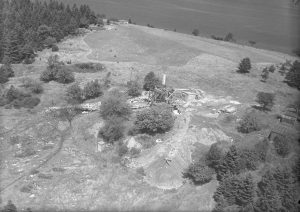 island. Since the 1850s, there have been documented treasure hunts, investigations, and excavations on Oak Island, but to no avail. There are many theories about what might be buried there, if anything really is. Areas of interest on the island with regard to treasure hunters include a location known as the Money Pit, a formation of boulders called Nolan’s Cross, the beach at Smith’s Cove, and a triangle-shaped swamp. The Money Pit area has been repeatedly excavated. Skeptics argue that there is no treasure and that the Money Pit is a natural phenomenon, but then they are probably look upon as wanting to keep any treasure for themselves. Until something is found, the treasure remains a mystery and a myth.
island. Since the 1850s, there have been documented treasure hunts, investigations, and excavations on Oak Island, but to no avail. There are many theories about what might be buried there, if anything really is. Areas of interest on the island with regard to treasure hunters include a location known as the Money Pit, a formation of boulders called Nolan’s Cross, the beach at Smith’s Cove, and a triangle-shaped swamp. The Money Pit area has been repeatedly excavated. Skeptics argue that there is no treasure and that the Money Pit is a natural phenomenon, but then they are probably look upon as wanting to keep any treasure for themselves. Until something is found, the treasure remains a mystery and a myth.

 My grandson, Caalab Royce; his dad, Travis; as well as my Dad, Allen Spencer and Uncle Bill Spencer; brother-in-law, Chris Hadlock; and nephew, Ryan Hadlock all play the guitar. There may be others in the family too, but they haven’t made it public knowledge. Any time I come across a some information, on guitars or their makers, I am interested, because of these people.
My grandson, Caalab Royce; his dad, Travis; as well as my Dad, Allen Spencer and Uncle Bill Spencer; brother-in-law, Chris Hadlock; and nephew, Ryan Hadlock all play the guitar. There may be others in the family too, but they haven’t made it public knowledge. Any time I come across a some information, on guitars or their makers, I am interested, because of these people.
Adolph Rickenbacker was born on April 1, 1886 in Basel, Switzerland as Adolph Rickenbacher. Following the death of his parents, he immigrated to the United States in 1891 with relatives. He settled in Columbus Ohio and later moved to southern California. Rickenbacher was a distant cousin to America’s top Flying Ace Eddie Rickenbacker. Rickenbacher decided that the name association would be helpful to him in his chosen career, so he Anglicized both his own name and that of his company, to Rickenbacker Manufacturing Company. His company made metal bodies for the National String Instrument Corporation. These metal bodies were used to make electric guitars. Through this connection, he met George Beauchamp and Paul Barth, and in 1931 they founded the Ro-Pat-In Company.
The three men produced the first cast aluminum versions of the lap steel guitar in 1932. In 1934, they renamed their company to the Electro String Instrument Corporation. Still, this was not to be a long term business. Music instruments tend to evolve and the resulting instrument looks little like the original. Production 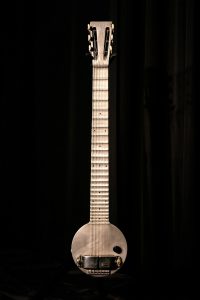
 ceased in 1939, after approximately 2,700 Frying Pan guitars had been produced. Rickenbacker, who was not convinced of the guitar business’s potential, continued manufacturing until 1953. Then he sold his company to Francis Cary Hall, a forerunner of the Southern California electric guitar boom. I wonder what might have been if the Electro String Instrument Corporation had continued on. While the signature “Frying Pan Guitar” might not have held it’s popularity, many other looks have followed.
ceased in 1939, after approximately 2,700 Frying Pan guitars had been produced. Rickenbacker, who was not convinced of the guitar business’s potential, continued manufacturing until 1953. Then he sold his company to Francis Cary Hall, a forerunner of the Southern California electric guitar boom. I wonder what might have been if the Electro String Instrument Corporation had continued on. While the signature “Frying Pan Guitar” might not have held it’s popularity, many other looks have followed.
Nevertheless, the “Frying Pan Guitar” had been a wonderful career for Rickenbacker. When he finally sold the business, Adolph Rickenbacker was 67 years old. He went on to live a over 20 more years before he died from cancer in Orange County, California on March 21, 1976 at the age of 89.
 I am sometimes amazed at the ability of humans to be heinously cruel to other human beings. From murders, to slave owners, to prisons or prisoner of war camps, man has the ability to act out evil in its purest form. Still, one would not have expected such evil in the American Revolutionary War era. Well, one would be wrong. We all know that war is a horrific event, but worse than losing life and limb in battle, seems to be the fate faced by those who are captured by the enemy forces, only to be tortured and even killed.
I am sometimes amazed at the ability of humans to be heinously cruel to other human beings. From murders, to slave owners, to prisons or prisoner of war camps, man has the ability to act out evil in its purest form. Still, one would not have expected such evil in the American Revolutionary War era. Well, one would be wrong. We all know that war is a horrific event, but worse than losing life and limb in battle, seems to be the fate faced by those who are captured by the enemy forces, only to be tortured and even killed.
During the Revolutionary War, being captured by the British often meant being sent to a prison ship, the worse of which was the HMS Jersey. Over the years of the war, approximately 11,000 prisoners of war perished on the HMS Jersey. The number of American field casualties during that war was approximately 4,500. That is a stunning difference. The HMS Jersey often held thousands of prisoners at one time, in quarters that were so close, that it could be likened to being packed in like sardines in a tin. There was no light, no medical care, barely any oxygen, and very little in the way of food and clean water. The guards on the prison ships were not concerned with keeping their prisoners alive, and HMS Jersey was the worst of them all.
The little food the prisoners were given was moldy, putrefied, and worm infested. The prisoners had to choose daily to eat the horrible food, or starve. One prisoner Ebenezer Fox, who survived said, “The bread was mostly mouldy, and filled with worms. It required considerable rapping upon the deck, before these worms could be dislodged from their lurking places in a biscuit. As for the pork, we were cheated out of it more than half the time, and when it was obtained one would have judged from its motley hues, exhibiting the consistence and appearance of variegated soap, that it was the flesh of the porpoise or sea hog, and had been an inhabitant of the ocean, rather than a sty. The provisions were generally damaged, and from the imperfect manner in which they were cooked were about as indigestible as grape shot.” That pretty much says it all, I would say. The British soldiers were seemingly unaffected by the image of prisoners banging their biscuits against the deck to remove worms, because this treatment continued throughout the conflict.
Because the prisoners were kept at sea, the smell of a piece of dirt from the shoes of a soldier back from shore leave became one of the prisoners’ greatest delights. I guess that one can always find some good, even in the worst situations, if one looks for it. Captain Dring, a survivor who wrote prolifically about his experiences on the Jersey, recalled one particularly strange consolation. When someone died on the ship, their remains were usually thrown overboard, but occasionally they were allowed to be taken ashore and laid to rest. Dring was part of a group that was tasked with digging graves on land. The men chosen for this duty were ecstatic to be on land again. Dring even took off his boots simply to feel the earth underneath his feet. However, when the crew came across a piece of broken-up turf, they did something extraordinary: “We went by a small patch of turf, some pieces of which we tore up from the earth, and obtained permission to carry them on board for our comrades to smell them. Circumstances like these may appear trifling to the careless reader; but let him be assured that they were far from being trifles to men situated as we had been. Sadly did we approach and reenter our foul and disgusting place of confinement. The pieces of turf which we carried on board were sought for by our fellow prisoners, with the greatest avidity, every fragment being passed by them from hand to hand, and its smell inhaled as if it had been a fragrant rose.”
The known fate of the men on board the prison ships, and especially HMS Jersey was a slow and painful death. Most knew better than to expect to survive their ordeal. They had seen too many of their comrades die right before their eyes, to have much hope that they could make it out. To make mattes worse, the majority of the prisoners aboard the Jersey were young, inexperienced farmhands, not hardened soldiers with survival experience. Only a few of Washington’s army were soldiers with any 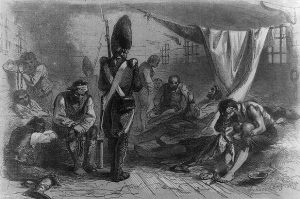 experience. The rest were provincial people, and many had never traveled beyond the limits of the small county where they lived. Imagine the horror of war, and then the conditions on HMS Jersey to the young, innocent men. The constant punishment, meager rations, lack of light, and lack of privacy could be tolerated, but the inactivity and helplessness most likely added depression and despair to their suffering. Times were different then, and there were things that were not available, but many of the things the prisoners suffered could have been avoided, especially the overcrowding and unsanitary conditions, but apparently they just didn’t care.
experience. The rest were provincial people, and many had never traveled beyond the limits of the small county where they lived. Imagine the horror of war, and then the conditions on HMS Jersey to the young, innocent men. The constant punishment, meager rations, lack of light, and lack of privacy could be tolerated, but the inactivity and helplessness most likely added depression and despair to their suffering. Times were different then, and there were things that were not available, but many of the things the prisoners suffered could have been avoided, especially the overcrowding and unsanitary conditions, but apparently they just didn’t care.
 These days, we all expect the latest new car to look different, to say the least, and strange, in some cases, but that is not really what we might have expected in the 1930s. Nevertheless, in 1933, they people might have been a little bit surprised to see the car designed by Richard Buckminster Fuller, an American architect, systems theorist, author, designer, inventor, and futurist. Fuller was born on July 12, 1895, in Milton, Massachusetts, the son of Richard Buckminster Fuller and Caroline Wolcott Andrews. The unusual middle name, Buckminster, was an ancestral family name. Like many kids, he tried numerous variations of his name. He used to sign his name differently each year in the guest register of his family summer vacation home at Bear Island, Maine. He finally settled on R. Buckminster Fuller. Not what I would have expected, but to each his own.
These days, we all expect the latest new car to look different, to say the least, and strange, in some cases, but that is not really what we might have expected in the 1930s. Nevertheless, in 1933, they people might have been a little bit surprised to see the car designed by Richard Buckminster Fuller, an American architect, systems theorist, author, designer, inventor, and futurist. Fuller was born on July 12, 1895, in Milton, Massachusetts, the son of Richard Buckminster Fuller and Caroline Wolcott Andrews. The unusual middle name, Buckminster, was an ancestral family name. Like many kids, he tried numerous variations of his name. He used to sign his name differently each year in the guest register of his family summer vacation home at Bear Island, Maine. He finally settled on R. Buckminster Fuller. Not what I would have expected, but to each his own.
Fuller married Ann Hewitt in 1917, and they would have two daughters, Alexandra born in 1918, and Allegra, born in 1927. Following the death of his daughter Alexandria in 1922 of complications from polio and spinal meningitis just before her fourth birthday, Fuller suffered with depression, even contemplating suicide. Then, he made a decision to live out his life as “an experiment to find what a single individual can contribute to changing the world and benefiting all humanity.”
In 1927, Fuller sketched the Dymaxion car under the name “4D transport.” The car was most unusual in its appearance. Part aircraft, part automobile, it actually had wings that inflated. Fuller asked a friend, sculptor, Isamu Noguchi to make more sketches of the car in 1932. The final design was an elongated teardrop body, with a rear third wheel that lifted off the ground and a tail fin. Fuller set up production of the Dymaxion car in a former Locomobile factory in Bridgeport in March 1933. The first model rolled out of the Bridgeport factory on July 12, 1933…Fuller’s 38th birthday. It had a steel chassis and a body made of ash wood, covered with an aluminum skin and topped with a painted canvas roof. It was designed to be able to reach a speed of 120 miles per hour and average 28 miles to the gallon of gasoline. The first model was sold to Gulf Oil, and dubbed the Dymaxion car. It went on display at the Century of Progress exposition in Chicago. Unfortunately, that October the professional driver Francis Turner was killed after the Dymaxion car turned over during a demonstration. The Dymaxion was cleared of responsibility in the ensuing investigation, but investors became scarce, despite the enthusiasm of the press and of celebrities such as the novelist H.G. Wells and the painter Diego Rivera.
The Dymaxion, along with the Nazi-built KdF-wagen (the forerunner of the Volkswagen Beetle), was one of several futuristic, rear-engined cars developed during the 1930s. Because of the tragic death of Francis Turner,  it was never mass-produced. Still, the Dymaxion helped lead to public acceptance of new streamlined passenger cars, such as the 1936 Lincoln Zephyr. The only surviving Dymaxion was featured in an exhibit dedicated to Fuller’s work at the Whitney Museum of American Art in New York City in 2008. The New York Times, in an article about the exhibit recalled Fuller’s own impressions of the Dymaxion, “‘I knew everyone would call it a car,’ he told the literary critic Hugh Kenner in the 1960s; instead, it was actually ‘the land-taxiing phase of a wingless, twin orientable jet stilts flying device.'” Interesting analogy…don’t you think?
it was never mass-produced. Still, the Dymaxion helped lead to public acceptance of new streamlined passenger cars, such as the 1936 Lincoln Zephyr. The only surviving Dymaxion was featured in an exhibit dedicated to Fuller’s work at the Whitney Museum of American Art in New York City in 2008. The New York Times, in an article about the exhibit recalled Fuller’s own impressions of the Dymaxion, “‘I knew everyone would call it a car,’ he told the literary critic Hugh Kenner in the 1960s; instead, it was actually ‘the land-taxiing phase of a wingless, twin orientable jet stilts flying device.'” Interesting analogy…don’t you think?

